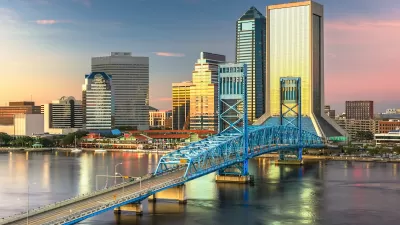A recent study emphasizes the importance of good road design and low speed limits in keeping pedestrians safe.

A new study of traffic deaths in Tennessee found a strong correlation between more pedestrian deaths and more crashes on “straight, multi-lane roads with speed limits over 35 miles per hour,” known as ‘stroads,’ that advocates say “combine the features of neighborhood streets with a car-oriented roads to deadly effect.” Kea Wilson describes the study in Streetsblog USA.
The study’s authors acknowledge that the size of vehicles can also be a factor in how deadly crashes are, “But the more important thing that we should be focusing on — and it's something that urban transportation professionals have a lot more control over — is speed on urban arterials.”
The study notes that Tennessee did not necessarily build more arterials during the time span that pedestrian deaths rose, but study author Christopher Cherry “suspects that a rising number of residents simply have no choice but to walk on the state's most-dangerous roads, particularly as incomes fall and poor residents who can't afford cars are pushed out of walkable downtowns and towards the sprawling fringe.” In other words, the suburbanization of poverty is putting more low-income people in harm’s way.
For Cherry, road design is a crucial key to improving safety. “We need to design roads where it’s almost impossible to kill someone.”
FULL STORY: Study: Yes, SUVs Are Deadlier Than Cars — But on Fast Arterials, Pedestrians Die No Matter What

Maui's Vacation Rental Debate Turns Ugly
Verbal attacks, misinformation campaigns and fistfights plague a high-stakes debate to convert thousands of vacation rentals into long-term housing.

Planetizen Federal Action Tracker
A weekly monitor of how Trump’s orders and actions are impacting planners and planning in America.

In Urban Planning, AI Prompting Could be the New Design Thinking
Creativity has long been key to great urban design. What if we see AI as our new creative partner?

How Trump's HUD Budget Proposal Would Harm Homelessness Response
Experts say the change to the HUD budget would make it more difficult to identify people who are homeless and connect them with services, and to prevent homelessness.

The Vast Potential of the Right-of-Way
One writer argues that the space between two building faces is the most important element of the built environment.

Florida Seniors Face Rising Homelessness Risk
High housing costs are pushing more seniors, many of them on a fixed income, into homelessness.
Urban Design for Planners 1: Software Tools
This six-course series explores essential urban design concepts using open source software and equips planners with the tools they need to participate fully in the urban design process.
Planning for Universal Design
Learn the tools for implementing Universal Design in planning regulations.
Gallatin County Department of Planning & Community Development
Heyer Gruel & Associates PA
JM Goldson LLC
City of Camden Redevelopment Agency
City of Astoria
Transportation Research & Education Center (TREC) at Portland State University
Jefferson Parish Government
Camden Redevelopment Agency
City of Claremont





























